Physical Address
304 North Cardinal St.
Dorchester Center, MA 02124
Physical Address
304 North Cardinal St.
Dorchester Center, MA 02124

Is your kitchen feeling a little…blah? Do you dream of a space that’s not only functional but also the heart of your home? A well-designed kitchen island can revolutionize your entire kitchen experience.
Think about it – more than just a countertop in the middle of the room, a thoughtfully planned island brings extra storage, creates a social hub, and adds visual interest to your kitchen. The Nordic design principle of balance between beauty and function applies perfectly here.
Let’s explore 24 kitchen island remodeling ideas that will transform your space from ordinary to extraordinary. From clever storage solutions to stunning material choices, there’s something here for every style and budget.
Kitchen islands are the unsung heroes of kitchen organization. Serving as command central for everything from meal prep to casual dining, their potential for storage is immense. Maximizing storage within your island is the key to maintaining that clean, minimal aesthetic that’s central to Nordic design while keeping essential tools and ingredients within arm’s reach.
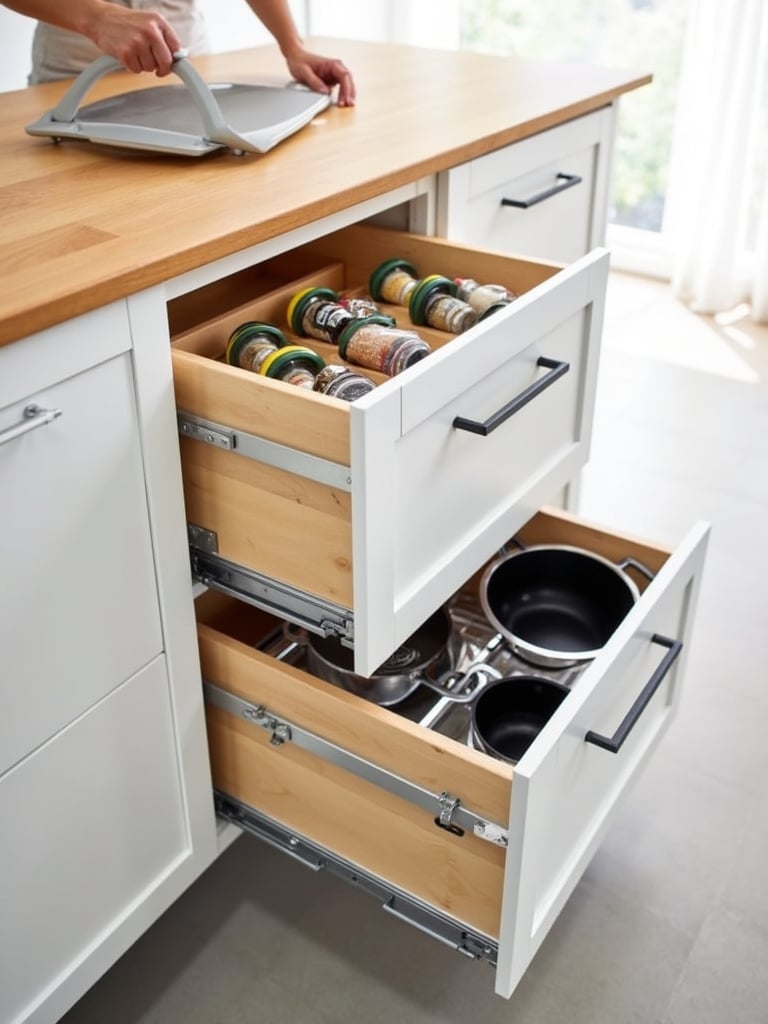
What makes island storage truly effective? Pull-out wonders! Consider options like pull-out spice racks that transform narrow spaces into organized spice havens, integrated cutting boards that offer instant extra prep space, or hidden trash and recycling bins that maintain hygiene without sacrificing style. These ingenious solutions utilize vertical space efficiently while maintaining the clean lines that are essential to Scandinavian design.
Here’s the inside story: with thoughtfully designed island storage, your kitchen will not only look more organized but function more efficiently. The clean countertops and accessible tools create a workspace that supports both creativity and calm.
The visual and functional success of your kitchen island hinges on getting the size and shape just right. In Nordic design, proportion is everything – an oversized island overwhelms a space, while one that’s too small feels insignificant. Start by measuring your kitchen dimensions, paying close attention to the work triangle formed by your sink, refrigerator, and cooktop. You’ll need to leave ample clearance – ideally 36-48 inches – around all sides of the island for comfortable movement.
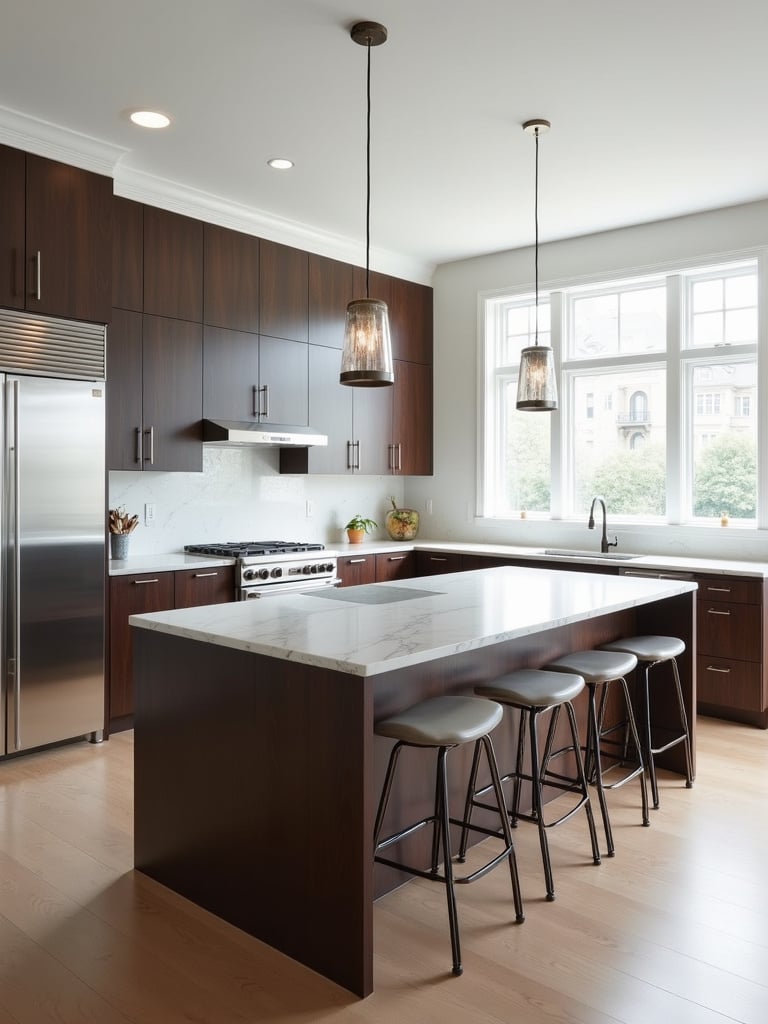
When it comes to shape, each option brings unique advantages. Rectangular islands are versatile workhorses that fit most kitchen layouts. Square islands bring pleasing symmetry to square kitchens. L-shaped islands excel in larger spaces, offering distinct zones. Round or oval islands soften the kitchen’s lines and foster a social atmosphere, embodying the hygge principle of creating warm, inviting spaces. Your choice should balance both function and the aesthetic harmony that’s central to Scandinavian design.
What complicates this is that the perfect island isn’t just about looks – it needs to enhance your kitchen’s workflow. Use painter’s tape to mark out proposed dimensions on your floor and live with the space for a few days before committing.
A kitchen island often becomes the social heart of the home, and comfortable seating is key to making it truly inviting. In true Nordic fashion, focus on both comfort and simplicity when selecting seating. Consider height first – standard counter height islands (36 inches) pair well with 24-26 inch bar stools, while bar-height islands (42 inches) need 30-inch stools. Features like back support, padding, swivel options, and footrests significantly impact comfort.

Bar stools and benches each bring distinct advantages to your island seating. Stools offer flexibility, a modern vibe, and tuck away easily, embodying the functional minimalism of Scandinavian design. Benches provide more seating capacity and a relaxed, informal feel that’s perfect for families. They can also incorporate under-seat storage – a clever space-saving solution that’s very much in line with Nordic design principles. The choice between them depends on your lifestyle, space constraints, and the overall aesthetic you’re creating.
The heart of the matter is that your island seating should invite people to gather, share meals, and connect – embodying the hygge principle of creating spaces that foster togetherness and well-being.
The countertop is arguably the most visually impactful element of your kitchen island remodeling project. Each material brings different qualities to your space. Quartz offers exceptional durability and a non-porous surface resistant to stains. Granite provides unique patterns and excellent heat resistance. Marble exudes elegance with its distinctive veining but requires more maintenance. Butcher block brings the natural warmth and tactile quality that’s essential in Nordic design, though it needs regular oiling.

How do you choose the right material for your space? Consider both aesthetics and function. Light countertops brighten spaces – a valuable quality in Scandinavian design, which emphasizes lightness. Dark options add drama and ground a space. Think about your island’s primary function – is it mainly for food prep, dining, or serving? This will influence your material choice. In Nordic design, natural materials are preferred for their authenticity and connection to nature, making butcher block or stone excellent choices.
Picture it this way: your countertop is both a workspace and a design statement that sets the tone for your entire kitchen. The right choice balances beauty and practicality – the cornerstone of Scandinavian design philosophy.
For a touch of contemporary sophistication that aligns perfectly with Nordic minimalism, consider a waterfall edge for your kitchen island countertop. This design detail, where the countertop material cascades vertically down the sides of the island to meet the floor, creates a continuous, seamless flow that’s both striking and elegant. It’s a perfect example of how simple, clean lines can create dramatic impact – a core principle in Scandinavian design.

Beyond its stunning aesthetics, waterfall edges offer practical benefits that align with the functionality central to Nordic design. They protect island cabinetry from everyday bumps and scuffs, extending its lifespan. The seamless design minimizes crevices where dirt can accumulate, making cleaning easier. They can also cleverly conceal wiring or plumbing on the island’s sides, maintaining the clean, uncluttered look that’s essential to Scandinavian spaces.
The surprising part is that while waterfall edges appear to be a purely aesthetic choice, they actually enhance both the beauty and functionality of your kitchen island – embodying the perfect balance that Nordic design strives for.
For serious cooks or busy households, a prep sink in the kitchen island can be a game-changer. It creates a dedicated zone for food preparation, separate from the main sink used for dishwashing. This supports the Nordic design principle of creating efficient, purposeful spaces where form follows function. A prep sink reduces congestion around the main sink, allows multiple people to work simultaneously, and promotes cleaner food prep by minimizing cross-contamination.
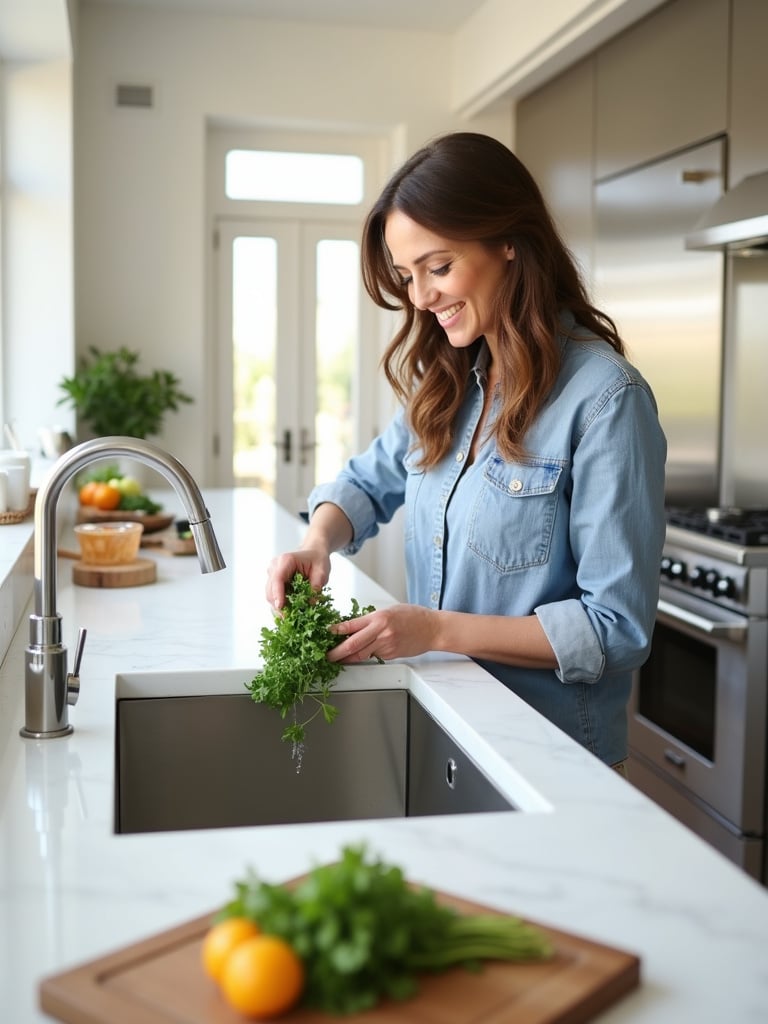
What size and type works best? It depends on your island’s dimensions and your cooking habits. Smaller islands benefit from compact round or square sinks, while larger islands can accommodate rectangular sinks with more space. Material choices matter too – stainless steel offers durability and easy cleaning, fireclay brings classic style, and composite materials provide color options. Consider sink depth as well – deeper sinks handle larger items, while shallower ones might be more comfortable for frequent use.
The breakthrough came when I realized a prep sink isn’t just about convenience – it fundamentally changes how you use your kitchen, creating distinct work zones that make the entire space function more efficiently. This zoning concept is central to thoughtful Scandinavian kitchen design.
Proper lighting is paramount in Nordic design, where natural light is treasured and artificial lighting is carefully planned to create warm, functional spaces. Task lighting for your kitchen island is especially critical since it often serves as a primary work area. It provides focused illumination for specific activities like food prep, cooking, or reading recipes, ensuring visibility, safety, and a more enjoyable cooking experience.
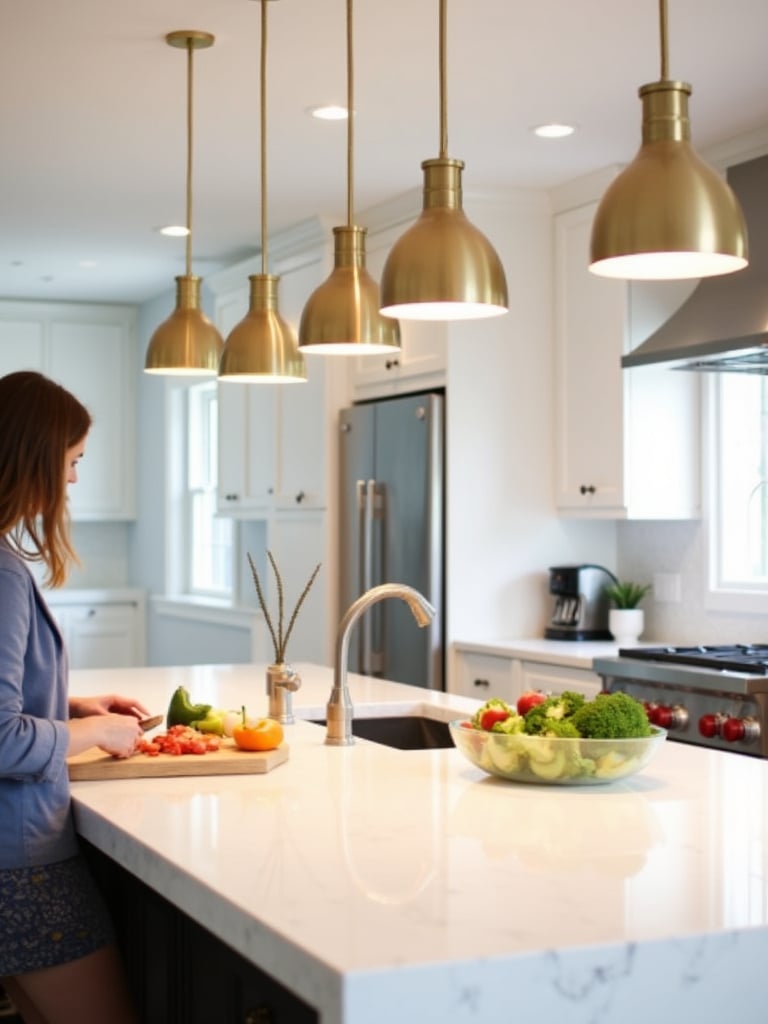
Different lighting types serve distinct purposes in illuminating your island. Pendant lights, hanging directly above, offer focused downlighting while serving as stylish focal points – perfect for adding a touch of personality to a minimal Nordic kitchen. Recessed lighting provides clean, unobtrusive illumination. Track lighting offers adjustable light heads for directing light where needed. Under-cabinet lighting (if applicable to your island design) provides direct countertop illumination without shadows. The best approach often combines lighting types for comprehensive coverage.
Let me paint you a picture: with well-designed task lighting, your kitchen island becomes a bright, inviting workspace by day and a warm, atmospheric gathering spot by evening – embodying the versatility and thoughtful functionality that defines Nordic design.
For kitchens that need to balance functionality with social interaction, a two-tiered island offers an elegant solution that aligns with Nordic design principles of clear purpose and defined spaces. This design creates distinct zones for different activities – typically a lower tier (36 inches) for food preparation and a higher tier (42 inches) for casual dining or socializing. This separation helps contain prep mess while offering comfortable heights for different activities.

The standard height difference between tiers is 6 inches, creating an ergonomic prep surface at counter height and a comfortable dining area at bar height. This thoughtful consideration of human comfort and function is central to Scandinavian design philosophy. The higher tier can also serve as a visual barrier, concealing prep messes from guests – maintaining the clean, organized aesthetic that’s so important in Nordic spaces.
The missing piece is often hidden storage within the transition between tiers. This space can be utilized for frequently used cooking utensils or small appliances, maximizing functionality in true Scandinavian fashion.
Open shelving on a kitchen island blends functionality with personal expression – a perfect match for Nordic design, which values both practicality and personal connection to objects. Open shelves offer easy access to frequently used items like cookbooks or serveware while allowing you to display carefully curated objects that bring joy and personality to your kitchen. This approach also makes smaller kitchens feel more spacious and airy compared to solid cabinetry.
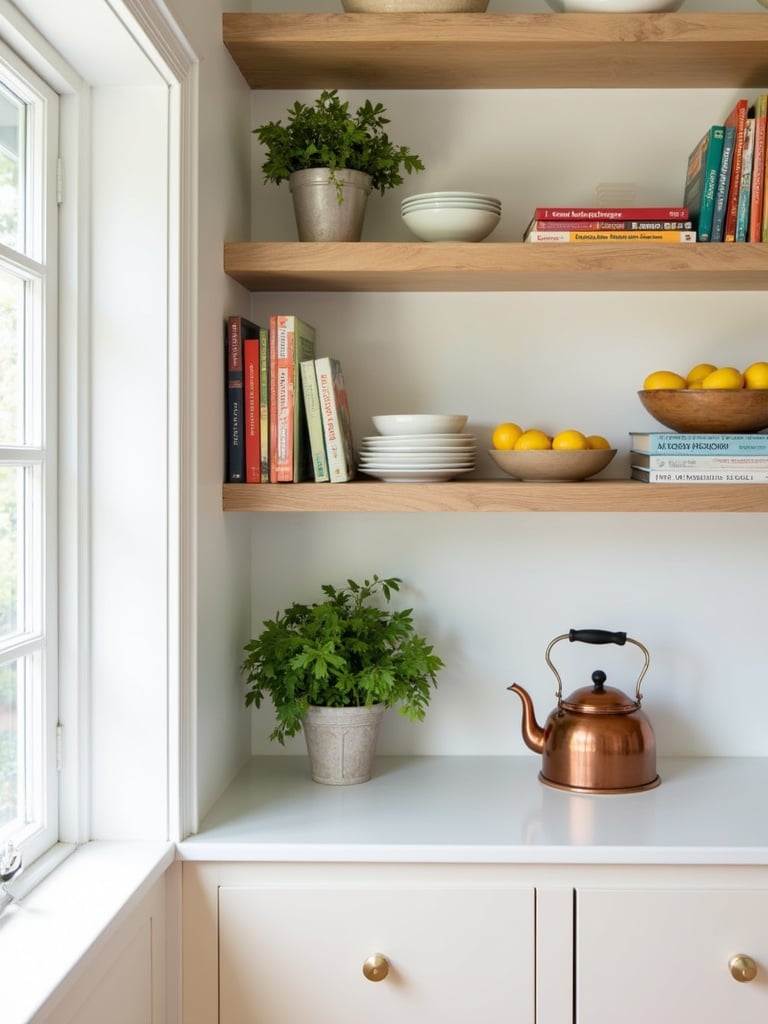
What items work best on open island shelving? In keeping with Scandinavian principles, focus on items that are both functional and beautiful. Display cookbooks with attractive covers, collections of handmade pottery, wooden cutting boards, or potted herbs. The key is to be selective – Nordic design emphasizes quality over quantity, with each item earning its place through both usefulness and beauty. Avoid clutter; a curated, organized display is essential to maintaining a calm, harmonious space.
“In Nordic design, we believe every object should earn its place through both beauty and function. Open shelving invites you to curate collections that are meaningful, useful, and visually pleasing.”
Integrating appliances directly into your kitchen island can significantly enhance functionality while creating the clean, streamlined aesthetic that’s central to Nordic design. This approach maximizes space by freeing up valuable countertop and wall areas, improves workflow by placing frequently used appliances within easy reach, and creates a seamless look that enhances visual harmony. It’s a perfect example of how thoughtful planning can make spaces work harder without visual clutter.
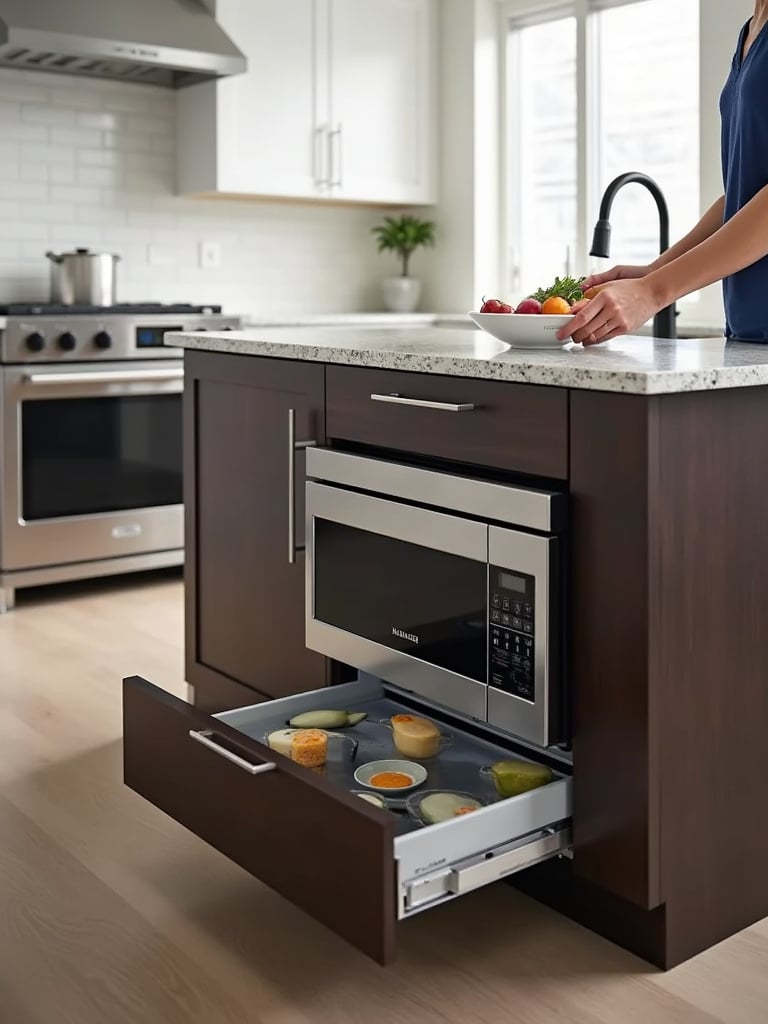
When planning for built-in appliances, several considerations align with Scandinavian design principles. Proper connections for electricity and plumbing must be planned early. Ventilation is essential for heat-generating appliances. Structural support is needed for heavier items like wine fridges. Ergonomic placement ensures comfortable use – a key consideration in human-centered Nordic design. And the island’s size must accommodate both the appliance and surrounding workspace without feeling cramped.
The game-changer happened when kitchen island remodeling began incorporating appliances thoughtfully rather than as afterthoughts. This integration creates a cohesive, functional workspace that supports how people actually live and cook – the ultimate goal of Nordic design.
The finish of your kitchen island dramatically impacts its style and integration with your overall kitchen design. Nordic design typically embraces light colors and natural wood tones to create bright, airy spaces. When choosing between paint and stain, consider your desired aesthetic and the island’s material. Paint offers a vast color palette and conceals wood grain, ideal for creating clean, consistent surfaces. Stain enhances natural wood grain, celebrating the material’s inherent beauty – a core value in Scandinavian design.

Choosing the right color requires careful consideration of your existing kitchen palette. You can match the island to cabinets for a cohesive, harmonious look typical in Nordic design, or choose a contrasting color to make it a focal point. If contrasting, select complementary colors or a tone that ties into other elements like backsplash or accessories. Always consider undertones to avoid clashing, and test samples in your kitchen lighting before committing – natural light interaction is especially important in Scandinavian spaces.
Things took an interesting turn when designers began using islands as color accents in otherwise neutral Nordic kitchens. This approach maintains the clean, light aesthetic while adding personality and visual interest through a thoughtfully placed color element.
Often overlooked, decorative hardware is like jewelry for your kitchen island – small details that make a significant impact. In Nordic design, where simplicity reigns, these subtle elements become even more important. Well-chosen hardware contributes to the overall aesthetic, tying design elements together while adding necessary functionality. The right pieces elevate the island’s look while providing comfortable grip and ease of use – embodying the Scandinavian principle that beautiful things should also work beautifully.
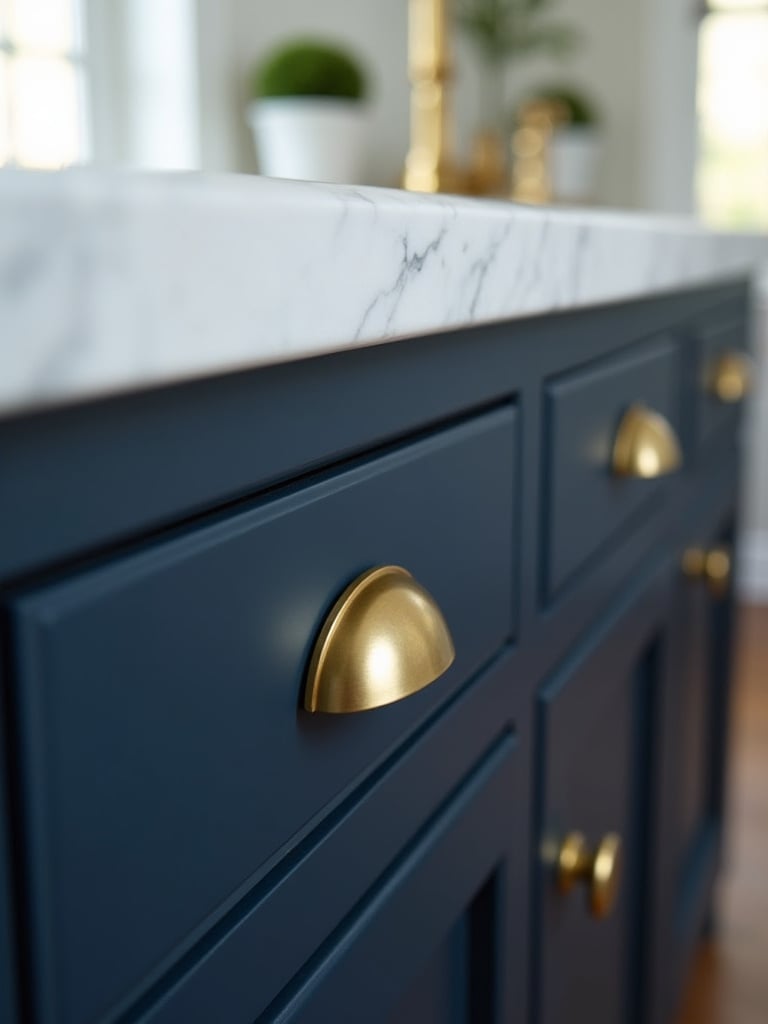
The options for hardware are vast, allowing for personalization within a clean Nordic framework. Knobs offer a minimalist look in round, square, or novelty shapes. Pulls provide a more substantial grip and can make bolder statements. Hardware comes in various finishes (brushed nickel, matte black, brass), materials (metal, wood, glass), and sizes. In Scandinavian design, natural materials like wood and leather are particularly appropriate, bringing warmth and tactile quality to the space.
You may have noticed that the most successful kitchen island remodeling projects pay attention to these small details. Hardware choices can reinforce the design language of your space while adding those personal touches that make a kitchen feel truly yours.
For passionate cooks who embrace the Nordic tradition of gathering around food preparation, a kitchen island with a built-in cooktop creates an ideal social cooking hub. This setup allows you to face guests while cooking, facilitating conversation and connection – central values in Scandinavian culture. Key considerations include proper ventilation through a powerful hood or downdraft system, professional installation of gas or electric lines, sufficient surrounding counter space, and thoughtful seating arrangements that allow comfortable interaction.
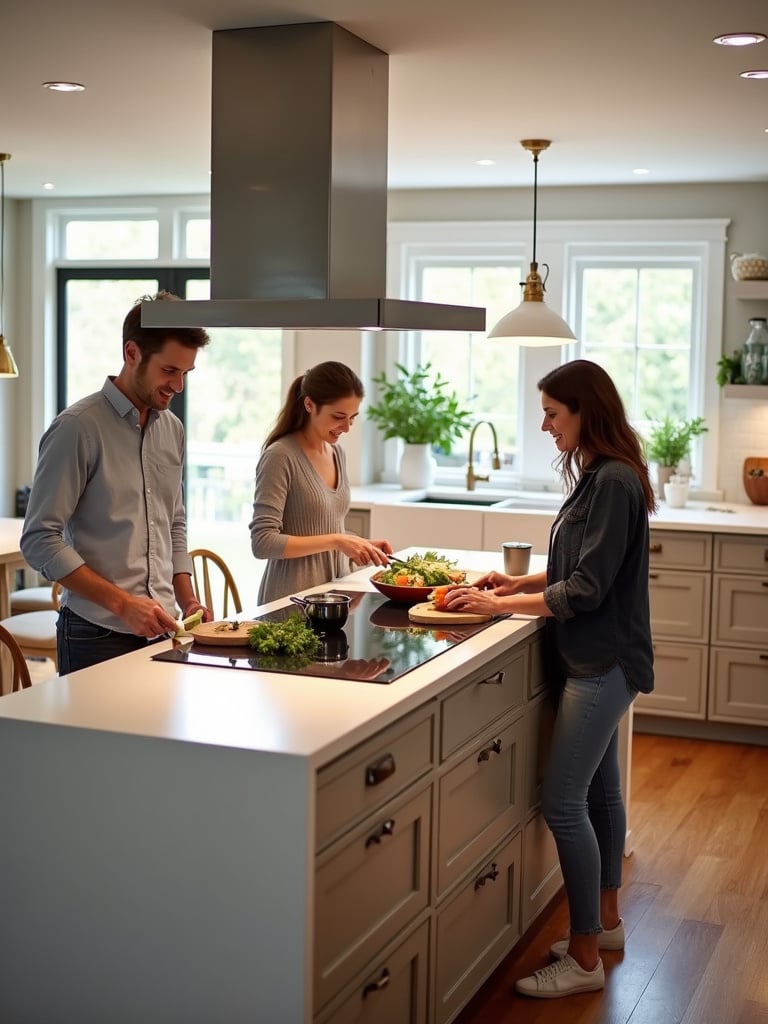
Different cooktop types suit different cooking styles and aesthetic preferences. Induction cooktops align perfectly with Nordic design – their sleek, minimal appearance maintains clean lines while offering fast heating and safety features. Gas cooktops provide the precise temperature control many chefs prefer. Electric cooktops with smooth ceramic surfaces offer easy cleaning and a modern look. Each option can work beautifully in a Nordic-inspired kitchen when integrated thoughtfully with surrounding materials and overall design language.
What really matters here is creating a space that supports both cooking and connection – a place where the preparation of food becomes a shared experience rather than an isolated task. This social aspect of cooking aligns perfectly with the Nordic value of togetherness.
In our tech-driven lives, electrical outlets in a kitchen island are no longer a luxury but a necessity that supports the functionality central to Nordic design. These outlets eliminate unsightly and hazardous extension cords, allow you to power small appliances directly on the island for efficient food prep, and provide charging stations for devices – transforming the island into a versatile workspace that meets modern needs while maintaining clean aesthetics.
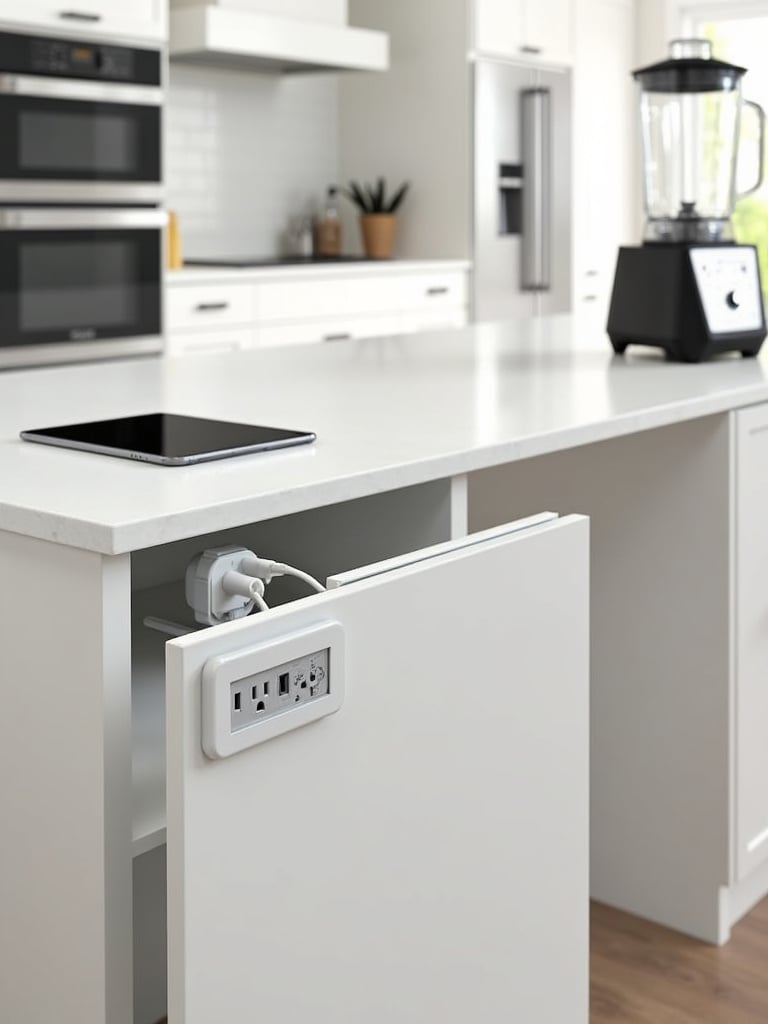
When planning outlets, consider both practical requirements and visual impact. The National Electrical Code typically requires at least one receptacle on islands 12 inches or wider, with GFCI protection near sinks. But beyond code requirements, think about placement – pop-up outlets or those integrated into drawers maintain the clean lines valued in Scandinavian design. USB ports accommodate device charging without adapters. And outlet covers can be selected to blend seamlessly with your island’s finish.
The tricky part is balancing sufficient power access with minimal visual disruption. The best kitchen island remodeling projects integrate outlets so thoughtfully that they’re nearly invisible until needed – maintaining the clean, uncluttered aesthetic that defines Nordic spaces.
For a kitchen island with character and a sustainable edge that aligns with Nordic values of resourcefulness and environmental responsibility, consider repurposing an old dresser. This approach is eco-friendly, giving old furniture new life. It adds unique vintage charm, creating a conversation piece with history and personality. It can be cost-effective compared to custom cabinetry. And it provides ready-made storage with existing drawers and cabinets – practical in the Scandinavian tradition.

When selecting a dresser for transformation, look for sturdy, solid wood pieces with sound construction – quality materials are valued in Nordic design. Consider height; you might need to add legs or a countertop to reach standard island height (36 inches). The dresser’s style should complement your kitchen’s aesthetic – clean lines for modern Nordic spaces, rustic elements for more traditional Scandinavian kitchens. This approach celebrates craftsmanship and the beauty of natural materials while giving them new purpose.
My breakthrough came when I realized that repurposing isn’t just about sustainability – it’s about creating pieces with soul and story in a world of mass production. This aligns perfectly with the Nordic appreciation for objects that carry meaning and history.
For kitchens where space is at a premium or layouts need to be adaptable, a mobile kitchen island offers a solution that embodies the Nordic principle of practical flexibility. This approach provides unparalleled versatility, allowing you to reconfigure your kitchen as needed for different activities. It’s ideal for smaller spaces where a fixed island might feel cramped – a common challenge in Scandinavian apartments. You can easily move it aside when not in use, maximizing floor space and maintaining the open, airy feeling valued in Nordic design.

Selecting the right casters is crucial for functionality and floor protection. Choose heavy-duty casters with a weight capacity matching or exceeding your island’s weight. Look for locking mechanisms to secure the island when needed. Consider your flooring – soft rubber or polyurethane casters protect hardwood, while larger diameter casters work better on textured surfaces. Factor in caster height, as it affects the overall island height and ergonomics – important considerations in human-centered Scandinavian design.
The potential here is enormous – a mobile island can serve as prep space, dining table, buffet, or workspace as needed, embodying the adaptability and efficiency that defines thoughtful Nordic design. This flexibility makes it perfect for modern, multifunctional homes.
Natural wood accents transform a kitchen island, adding the warmth and organic quality that’s essential to Nordic design. Wood brings an inviting feel to kitchens that might otherwise feel sterile with modern materials. It creates a comfortable atmosphere and adds timeless quality, connecting spaces to nature – a central value in Scandinavian design philosophy. The character and patina wood develops over time adds depth and authenticity to your kitchen island.
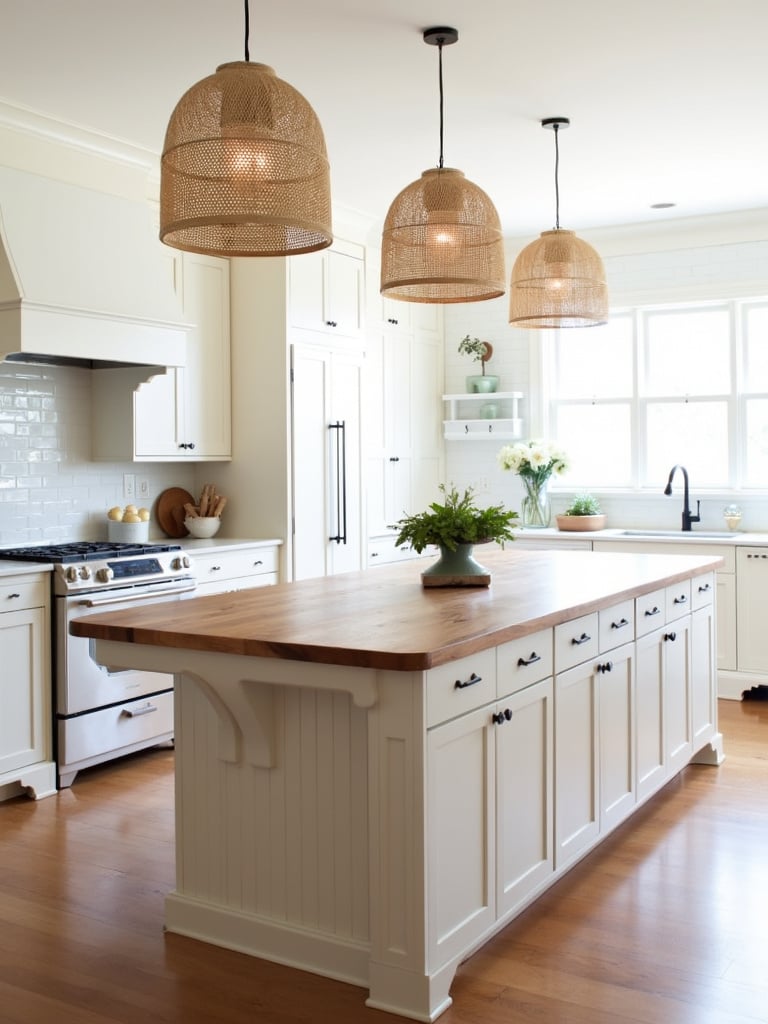
When selecting wood for your island, consider both practical and aesthetic qualities. Durable hardwoods like oak, maple, walnut, and cherry work beautifully in kitchen settings. Oak offers classic durability with pronounced grain. Maple provides a lighter, neutral backdrop. Walnut brings rich, dark tones and beautiful grain patterns. Reclaimed wood adds character and sustainability credentials. In true Nordic fashion, choose woods that will age gracefully, developing character rather than simply wearing out.
Let that sink in for a moment – in a world of synthetic surfaces and perfect finishes, natural wood connects us to nature and craftsmanship, adding soul to our spaces. This connection to natural materials is fundamental to the Nordic design approach.
A kitchen island, often the busiest spot in the kitchen, demands materials that withstand daily wear while maintaining their beauty – a perfect application of the Nordic principle that function and aesthetics must work together. Durable materials resist scratches, stains, heat, and impact, ensuring your island looks and functions well for years. This longevity aligns with the Scandinavian value of investing in quality rather than frequently replacing worn items – both economically and environmentally sound.

What makes a material truly “easy-to-clean” in a kitchen setting? Look for non-porous surfaces or those with proper sealing to prevent liquids and food from penetrating. Smooth surfaces, minimal grout lines (or sealed grout), and stain resistance simplify maintenance. Materials like quartz, solid surface, stainless steel, and properly sealed natural stone or wood all offer different aesthetics with good cleanability. This practicality is central to Nordic design, which values beautiful spaces that support daily life without creating maintenance burdens.
Do you see how huge that is? When your kitchen island materials are both beautiful and practical, you spend less time cleaning and more time enjoying your space – exactly what Scandinavian design aims to achieve.
An inclusive kitchen design considers the needs of all users, embodying the Nordic value of democratic design that works for everyone. Accessibility ensures your island is usable and comfortable regardless of age, height, or physical abilities. It promotes inclusivity, allowing all household members and guests to participate in cooking and socializing. This thoughtful approach to human needs is central to Scandinavian design philosophy, which places people at the center of all design decisions.

Common accessibility challenges include counter heights that don’t work for all users, insufficient knee clearance for seated users, inadequate maneuvering space, poorly placed appliances, and lack of adjustable features. Address these by considering varied counter heights or adjustable sections, ensuring at least one area has knee clearance for seated users, maintaining clear pathways around the island (minimum 42 inches), and placing frequently used items within easy reach. These considerations create a more welcoming, usable space for everyone.
The ripple effects are enormous – when your kitchen island works for everyone, it truly becomes the heart of the home, fostering the togetherness and equality that are cornerstone values in Nordic culture and design.
In today’s connected world, a charging station in your kitchen island represents the Nordic principle of adapting design to contemporary needs while maintaining clean aesthetics. Kitchens are hubs for activity, including using devices for recipes, entertainment, and communication. A charging station eliminates countertop clutter from cords and adapters, providing an organized solution that maintains the minimal, uncluttered look valued in Scandinavian design. It also protects electronics from potential kitchen spills and damage.

Several charging station styles work well in kitchen islands. Built-in outlets with USB ports offer a clean look when integrated into the surface or side panels. Hidden charging drawers discreetly conceal cables and devices completely. Pop-up charging stations remain flush with the counter when not in use. Wireless charging pads can be embedded in the countertop for a sleek, minimalist aesthetic that’s perfectly aligned with Nordic design principles. The best choice depends on your device needs and how important it is to keep technology visually minimized in your space.
It works something like this: thoughtful integration of modern necessities like charging stations allows your kitchen to function efficiently for today’s lifestyle while maintaining the clean, uncluttered aesthetic that makes Nordic spaces so calming and timeless.
Extend the functionality of your kitchen island by adding a breakfast bar – a perfect example of the Nordic approach to multipurpose design elements. This addition provides a dedicated casual dining space, perfect for quick meals and snacks. It encourages interaction while cooking, creating opportunities for connection that are valued in Scandinavian culture. It offers extra seating for guests without requiring additional furniture. And it can add visual interest to a large island, breaking up the mass in an aesthetically pleasing way.
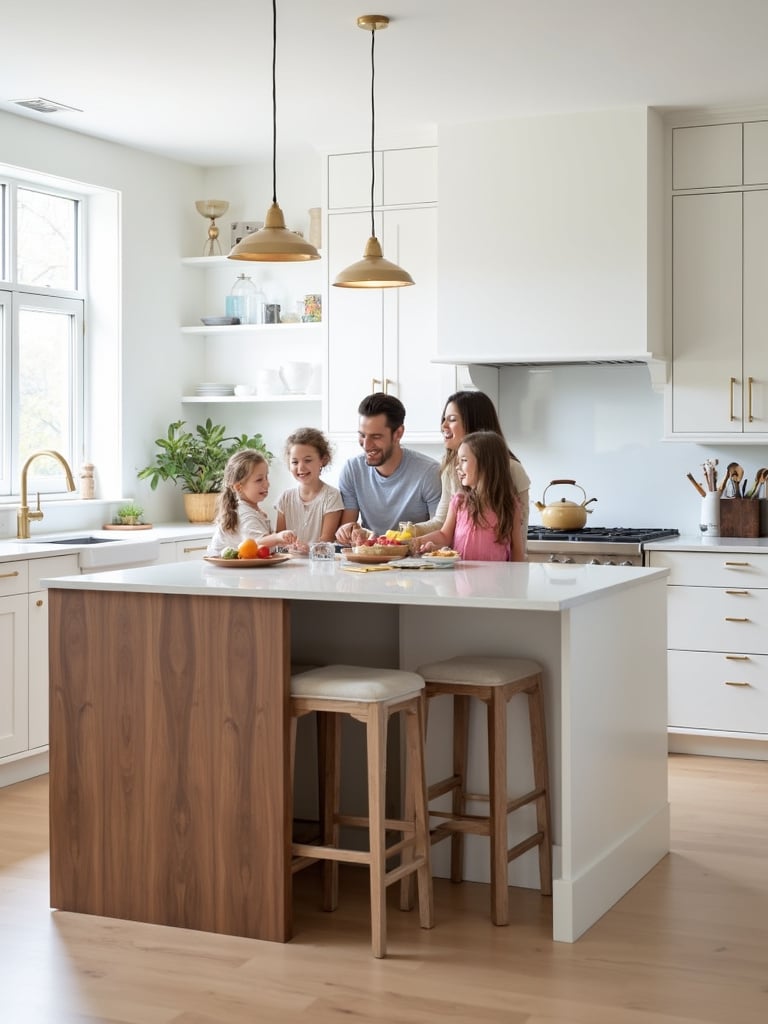
Different design styles offer various aesthetic and functional benefits. Cantilevered extensions create a floating effect that maintains open floor space – a priority in Nordic design. Waterfall edge extensions offer a seamless modern look. Butcher block extensions add warmth through natural materials – another Scandinavian design staple. Raised bars can hide countertop clutter, maintaining the clean look that’s essential to Nordic spaces. Choose a style that complements your kitchen’s overall design language while meeting your specific needs.
The crucial element is that a breakfast bar transforms your island from a work surface into a gathering place, supporting the Nordic value of spaces that bring people together around food and conversation. This social dimension is what truly makes a house feel like a home.
Wainscoting or shiplap can elevate your kitchen island’s design, adding texture and character while maintaining the clean lines valued in Nordic design. Wainscoting typically features decorative wall paneling, often with raised panels, offering a more traditional or formal look. Shiplap consists of horizontal wooden planks with overlapping edges creating subtle shadow lines, providing a rustic or coastal aesthetic that works beautifully in Scandinavian-inspired spaces. Both can transform an island from basic to distinctive.

The benefits of adding these textural elements align with Nordic design principles of creating visual interest through texture rather than clutter. They enhance aesthetic appeal by adding dimension and character. They define the island as a focal point without requiring bold colors or ornate details. They provide some protection to the island’s surface from scuffs and bumps. And they can be painted in light, neutral tones typical of Scandinavian spaces or used to introduce subtle contrast through natural wood finishes.
Here’s where everything changes – these simple textural additions can completely transform the feel of your kitchen island without adding visual noise, maintaining the calm, harmonious atmosphere that’s the hallmark of Nordic interiors.
Bring life and freshness to your kitchen island with a built-in herb garden – a perfect expression of the Nordic connection to nature and practical beauty. This feature provides fresh herbs readily available for cooking, enhancing both flavor and nutrition. It adds natural beauty and vibrancy to the kitchen, bringing the outdoors in – a key aspect of Scandinavian design, which seeks to maintain connection with nature even indoors. It’s a sustainable practice that reduces packaging waste and food miles, aligning with Nordic environmental values.

When designing a built-in herb garden, several considerations ensure success. Light is paramount; ensure adequate natural sunlight or install grow lights. Drainage is crucial; containers need proper drainage holes and layers to prevent root rot. Size and accessibility matter; the garden should be large enough for plants to thrive and easily accessible for watering and harvesting. Material selection should be water-resistant and integrate well with your island’s design. Popular herbs like basil, chives, parsley, and thyme not only taste wonderful but add varied textures and shades of green that enhance your kitchen’s visual appeal.
The stumbling block is often maintenance – but with thoughtful design and selection of herbs that share similar care requirements, your island garden can thrive with minimal effort while bringing daily joy and freshness to your cooking and your space.
Accessories and décor are the final flourish that truly personalizes your kitchen island, reflecting the Nordic belief that spaces should express the personality and values of those who live in them. These elements transform a functional island into a focal point that enhances your kitchen’s overall aesthetic. They add warmth and character, preventing the sterile feel that can sometimes result from too much minimalism. Thoughtfully chosen items complement your kitchen’s design theme and color palette, creating a cohesive and inviting space.

What types of accessories work well on a kitchen island? In keeping with Nordic design principles, choose items that are both beautiful and useful – decorative bowls that hold fruit, stylish containers for utensils, or handcrafted cutting boards that can be displayed vertically when not in use. Incorporate natural elements like small potted plants or flowers in simple vases. Use decorative storage baskets for open shelving. The key is selectivity – choose fewer, higher-quality items rather than many small decorations, maintaining the uncluttered aesthetic that’s central to Scandinavian design.
“The true essence of Nordic design lies in the details – those carefully selected objects that bring joy through both their beauty and their purpose. These finishing touches transform a house into a home.”
From maximizing storage to adding personal touches, these kitchen island remodeling ideas offer a wealth of inspiration to transform your space. The beauty of Nordic design lies in its adaptability – these principles can be applied to any style preference, from ultra-modern to warmly traditional, while maintaining the core values of functionality, simplicity, and connection to nature.
Whether you choose to incorporate just a few elements or embark on a complete island overhaul, the impact on your kitchen’s functionality and style will be significant. Remember that the most successful kitchen islands balance practicality with beauty, creating spaces that work efficiently while bringing daily joy – the ultimate goal of Scandinavian design.
So take these ideas, adapt them to your unique space and needs, and create a kitchen island that’s not just beautiful, but truly the heart of your home – a place where functionality meets warmth, and where the simple act of preparing food becomes one of the day’s greatest pleasures.